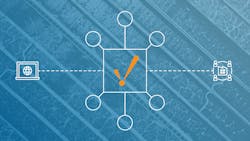Remote Monitoring and Control: Best Practices for Water Utilities
In the wake of the COVID-19 pandemic, a paradigm shift toward remote work has permanently altered workforce considerations for many industries—and the water and wastewater sector is no exception. Given this ongoing change, water utilities’ ability to remotely monitor and control critical processes is shifting from a matter of convenience to a matter of necessity.
Adopting remote process monitoring and control technology comes with a host of considerations for utilities, including security best practices, budget concerns and scaling solutions properly to their application. Luckily for forward-thinking utilities, today’s innovative solutions are secure, customizable and cost-effective. Read on for some key concepts to understand before implementing a new remote monitoring or control system.
The Basics of Remote Monitoring
It’s important to note that remote monitoring and remote control are two separate solutions. Although the two are often combined for optimal results, they each come with their own factors to examine.
So what is remote monitoring? During a webinar on the topic, Don Pearson, chief strategy officer at Inductive Automation, defined it as “a process or a system for controlling a facility or operation through automation.” Remote monitoring allows operators to instantly check on a process on the factory floor without needing to physically be there. Not only does this make an operator’s job easier, but it also eliminates the need for on-site supervision after working hours. A reduced need for on-site workers ultimately leads to reduced costs and improved safety.
The Basics of Remote Process Control
Remote process control, on the other hand, allows operators to take action based on what they learn through monitoring.
“For example, an operator or a manager can check on the temperature of the warehouse from their home and turn the temperature up or down if necessary,” Pearson said.
Remote process control doubles down on the benefits of remote monitoring by further eliminating the need for manual control and maintenance and reducing operational costs. With off-site control capabilities, plants can plan to only send workers to the site when necessary.
There are two main levels of remote process control systems. The first and most common type are systems that control an individual plant or site. The second type are higher-level systems that involve central or cloud monitoring control in multiple plants or sites, allowing users to control various processes simultaneously across different areas.
Ignition: A Solution for Monitoring and Control
While remote monitoring and control are separate tactics, tools like Inductive Automation’s Ignition software offer both capabilities in one easy-to-use solution. Ignition serves as a central hub for the plant floor, allowing users to design any industrial application and connect data with ease. An unlimited licensing model means that users can connect to any amount of data tags, devices and databases for the price of one server. Users can connect to any equipment in their system, including mobile devices, PLCs, touch panels and desktop PCs using any operating system.
Ignition Perspective, a new visualization module for the platform, allows users to easily create mobile-responsive applications. A visual drag-and-drop interface means you don’t need to know any HTML5 or CSS to build an application.
Security Best Practices
When implementing remote solutions, it’s crucial for water utilities to follow cybersecurity best practices to protect systems from bad actors. While solutions like Ignition come with built-in security mechanisms, utilities still need to take action to secure their networks.
Kevin McClusky, co-director of sales engineering at Inductive Automation, highlighted a few security best practices:
- Encrypt your communication data. This is the most important step you can take to protect your data from being intercepted by a third party.
- Use a VPN when possible to allow for a secure, private connection.
- Consider using two-factor authentication for an added layer of security.
- Set up security zones, which evaluate incoming connections and allow you to segment permissions based on the source and location of the connection.
Given the higher stakes, McClusky notes that security becomes even more crucial when it comes to remote process control. As such, utilities opting for remote control capabilities will need to invest in more robust security measures.
As remote work continues to solidify as part of the new normal, experts are encouraging critical infrastructure organizations to evaluate their remote capabilities and cybersecurity efforts. With tools like Inductive Automation’s Ignition, utilities will be equipped to meet the moment. For more insight and use case examples, check out Inductive Automation’s recent webinars on remote monitoring and remote process control.
